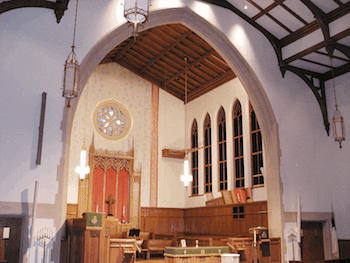“The bottom line is that we’ve demoed this system in four different churches, and ended up installing it in each one. So we’re four for four, and those churches are just ecstatic.” That’s how Tim Badger, president of Alstage Sound & Lighting in Apple Creek, Ohio, sums up his experience with the Vari-directional Array, Bosch’s latest innovation in public address sound. The system is a self-powered, electronically-controlled loudspeaker column array with integrated digital signal processing (DSP) that provides unprecedented user control over the coverage pattern.
Bosch's Vari-directional Array is featured in this Canton, OH church.
Specifically designed for maximum intelligibility in large reverberant spaces, the Bosch Vari-directional Array is ideal for houses of worship (HOW) whose hard-surfaced interior walls are susceptible to excess reflection of uncontrolled sound energy, according to the company.
Badger’s initial experience with the Vari-directional Array came at St. John's United Church of Christ in Dover, Ohio, whose sanctuary is almost 110 feet in length and over 40 feet wide, with a 20-foot balcony on the wall opposite the altar. The room has stucco block walls, lots of stained glass, minimal carpeting on the hard floor, and a 34-foot peaked ceiling of solid walnut. The organ and choir used in the church’s traditional services benefit from the cathedral-like sound of the hard-surfaced interior, but for many congregants it used to be a constant challenge to make out what the pastor was saying.
Part of the problem was the positioning of the old PA system’s two 12-inch two-way loudspeakers, which were mounted high on the front wall and pointed straight out toward the rear wall. By directing sound energy over the congregation’s heads and onto a highly reflective surface, the system added volume without aiding the comprehension of the spoken word. A staggered multi-box system running down each side might have improved the coverage pattern issue, keeping the sound on the seats and off the walls. But both the boxes themselves and the wiring required to reach them would have been out of place in the church’s traditional interior, which is an integral part of its identity.
“When I discussed the staggered speaker option with the church,” Badger said, “I told them there was no way to hide the wiring without using lots of wire mold. That was an issue for them. And then I remembered that Bosch had recently come out with the Vari-directional Array here in the U.S. So I contacted our representative, Jason Jacquemain at C.L. Pugh in Brunswick, Ohio, and he brought in a demo unit that we set up for the church to use for two services.”
Badger believes that demo-ing has been the key to getting his customers to understand what the Vari-directional Array can do for them. “Next to a full acoustical treatment of the room—which costs a lot more and creates its own aesthetic issues in traditional spaces—this is the best solution we’ve seen so far for reverberant rooms,” he said. “But when people just look at a picture of it without having heard it, and you tell them what it costs, you’re maybe going to raise a few eyebrows. With a demo they can hear the difference it makes in their own room, especially when you steer the coverage pattern with the system’s built-in DSP. It’s amazing to hear how the intelligibility can be increased so much.”
The Vari-directional Array’s aiming software is designed for easy set-up; it can be as easy as entering where the front row starts and the last row ends and pressing “Update” – then set the gain and make any necessary EQ adjustments.
A case in point is Badger’s experience at St. John's United. When he and Jacquemain came to pick up the demo system, “The church was so pleased with what they heard that they gave me the go-ahead right then and there. They were able to hear the spoken word clearly with exceptional coverage, and they were very happy about not needing to install staggered speakers and the ugly wire mold that requires.”
The church was no doubt pleased as well with the fact that the total installed cost of the Vari-directional Array approach—supplemented with a pair of Electro-Voice EVID 4.2s for light balcony fill—came in at about half of the staggered system design.
“Jason did the EASE modeling,” Badger said, “and we ended up needing only one vertical array, which was made up of one LA3-VARI-BH base unit and one LA3-VARI-E extension.” Mounted with the bottom 12 feet up on the stage-left wall, the array is close to eight feet tall but less than six inches wide. “It’s positioned to blend into the aesthetics,” Badger said. “You hardly notice that it’s there.”










